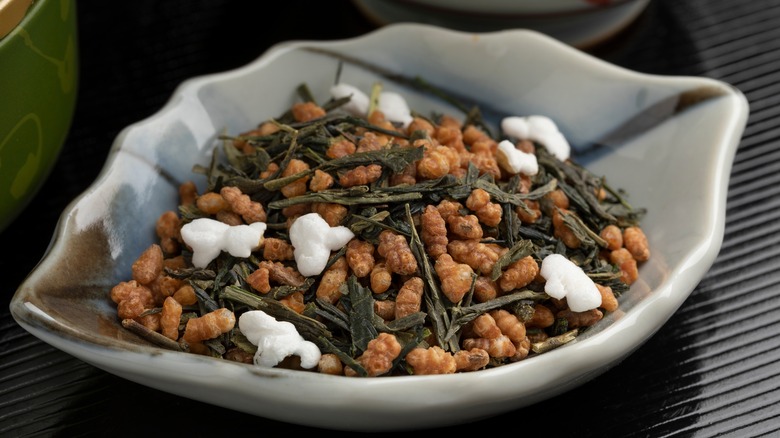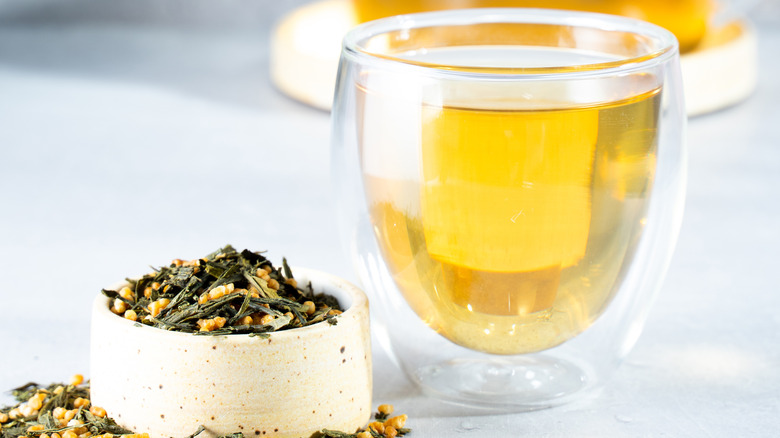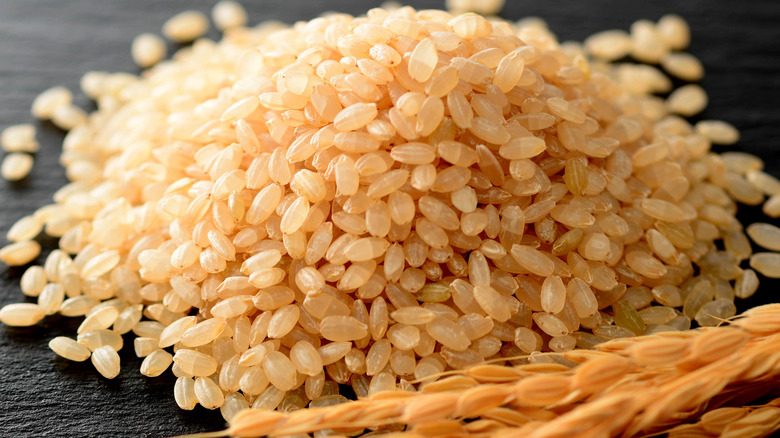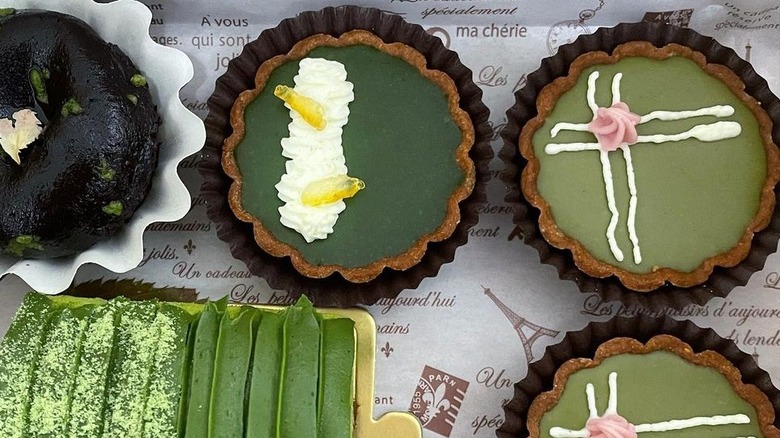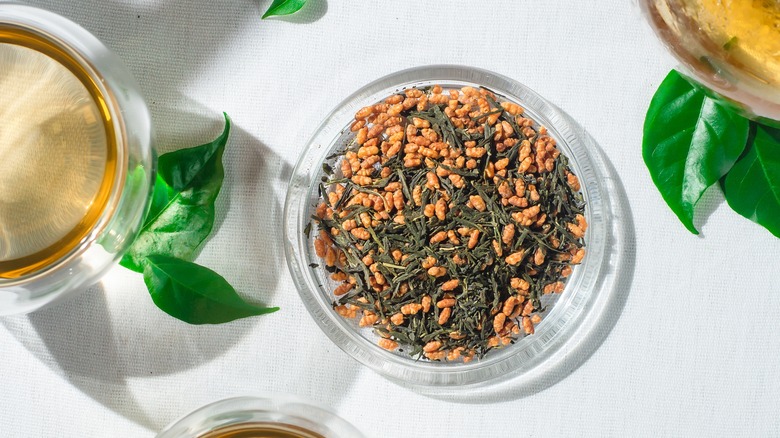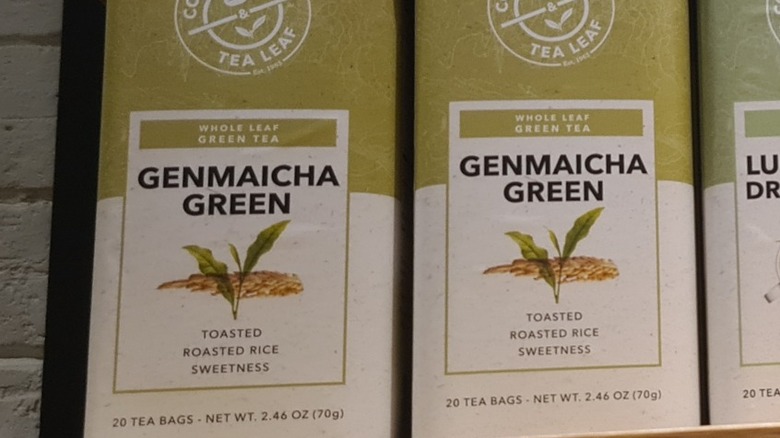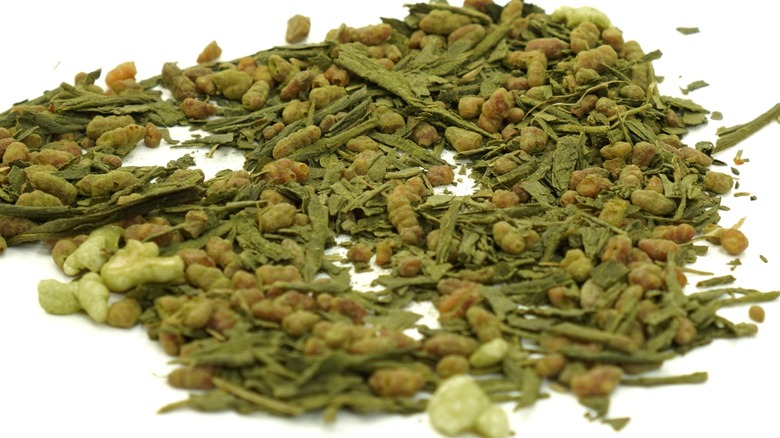Genmaicha Is The Japanese Pantry Staple That Elevates Stir-Fry And More
Tea comes in a dizzying array of varieties — in fact, experts estimate more than 20,000 teas exist. From matcha to jasmine, each of the types and subtypes of tea exhibits its own qualities. Japan alone has more than a dozen categories; talk about brewing possibilities.
For a low-caffeine variant, turn to Japanese genmaicha. Made with toasted brown or white rice and green tea, the beverage has a soothing toasted flavor underlaid by an herbal body. Its gentle taste and affordable price have increased its popularity and many now enjoy it before bed. But this tea can be used for cooking, too — melding with everything from rice dishes to stir-fries and tasty green-hued cakes.
Unlike other teas, genmaicha has both textural and flavor elements. Those lovely toasty, crispy rice kernels expand when heated, which is why it's nicknamed popcorn tea. This makes it stand out among other tea varieties and a compelling ingredient in culinary applications, too. Let's find out all the details.
What is genmaicha?
The crafty use of rice in tea took off for economic reasons. At the start of the 20th century, green tea prices were high in Japan. To improve the flavor of bitter and cheaper late-harvest leaves known as bancha, tea-makers started mixing in toasted rice. Not only did the ingredient soften off-putting flavors, but it also expanded the volume of the beverage. Genmaihca enabled the sipping of more green tea cups for less money.
Genmai translates to brown rice in Japanese; however, both white and brown rice are utilized for its creation. Genmaicha is defined by the grain's toasting process (which browns the rice), rather than its precise components. The drink has evolved from its low-grade tea origins and now includes leaves of all varieties. Tea makers mix things up by using other green teas, like matcha and hojicha. Such diversity means that there are many genmaicha varieties to choose from, all dependably underlaid with a toasted note. Here's how this unique tea is created.
How is genmaicha made?
Although the rice kernels in genmaicha have a crisp texture, they are not raw. First, they're soaked in water, integrating moisture content prior to heat application. Next, the rice is steamed to a more water-saturated consistency than usual. Then, there's a subsequent air-drying process, followed by the roasting that lends genmaicha its characteristic nutty, toasted flavor. Factors such as temperature and kernel moisture impact the popping process; not all of the rice expands.
Once roasted, the rice is known as genmai (though this is also the word for brown rice), and is ready for mixing with green tea. Once it's combined with the processed leaves in a one-to-one ratio it is ready to be brewed. Some producers add further elements at this stage, such as a coating of matcha powder over everything, or other rice and tea bases. Genmaicha can also deviate in ratios, and production methods, meaning there's considerable variety in flavor depending on the brand.
How to drink and eat genmaicha
Most commonly, genmaicha is steeped just like other teas. It's necessary to keep the water temperature below boiling so as not to ruin the delicate flavor of the green leaves. As a result, that means brewing at 170-180 degrees Fahrenheit for two to three minutes. For half a cup of water, just over a tablespoon of tea leaves is about right, though this is all adjustable to your own taste. And with its robust flavor, a batch of genmaicha can be reused up to five times. It can also be brewed with cold water, by infusion in the fridge for two hours.
Although delicious as a daily drink, genmaicha works well with many foods. With a high-heat sear, the kernels will further pop into crunchy morsels, perfect in a stir-fry or as a toasty-flavored topping for steamed veg and meat dishes. In Japan, the prepared tea is poured over rice bowls, in a dish known as ochazuke. Or when powdered with a quick blitz in the blender, genmaicha can be used as a delicious flavoring and coloring for cakes, bread, ice cream, pancakes, and other desserts. The tea's savory flavor integrates well into both sweet and savory foods.
Nutrition of genmaicha
Genmaicha offers similar health benefits to other green teas, albeit in a lower concentration. With the inclusion of rice, as well as frequent use of bancha, it contains less caffeine — from 10 to 15 milligrams a cup, while a full-bodied cup of green tea usually has between 30 and 50 milligrams.
Genmaicha's most prominent health benefit is due to catechins, a compound found in all green teas, which has immune-boosting and anti-oxidant effects. Catechins aid with disease resistance and improve heart health, especially with frequent consumption. If there is brown rice in the batch, this adds further immune-boosting qualities with its antioxidant content. And sencha tea varieties offer large concentrations of L-theanine, which elevates mood and mental function while negating some of caffeine's effects, notes Healthline. So if the aim of genmaicha consumption is for its health benefits, opt for varieties made with sencha or even coated in matcha. These higher grades of green tea will offer more beneficial nutritional qualities, though also come with a higher caffeine content.
Where to buy genmaicha
In Japan, genmaicha is ubiquitous, available in the vast majority of tea rooms, as well as at grocery stores. It's especially popular in Kyoto, where many varieties are sold at the market. Away from Japan, the best place to purchase genmaicha is online or from a reputable tea dealer.
Genmaicha is not only sold loose-leaf but also in tea bags, powdered, and in formats specifically for adding to baking. Combined with the assortment of grades and variations, it's a good idea to carefully read the descriptions to buy the right tea for the right application.
If you are keen to personalize the tea's flavor, it's possible to make genmaicha at home. Just take care during the roasting process — incorrectly toasting the rice will result in an off-putting burnt-tasting tea. So, given the affordability of genmaicha, buy a premade tea first to see what its delicious nutty flavor should taste like. Then, experiment as much as you like.
Other varieties of genmaicha
Beyond its original bancha-based recipe, genmaicha most frequently varies based on tea type. Younger, higher-grade tea leaves create sencha genmaicha, which has a higher caffeine content and a more herbal taste. Conversely, a lower-caffeine variant is made with hojicha, creating hoji genmaicha, which has a smokier flavor. Another popular variety is matcha-iri genmaicha, which has a bright green hue due to added powdered matcha. This varietal has a more mellow, earthy taste and a richer mouthfeel.
Varieties continue with gyokuro genmaicha, made with specially grown, younger tea sprouts. This genmaicha variety has a sweet, soothing flavor. Some genmaicha producers integrate additional flavors into the tea mix, like a sweetener or herbal addition, or even rose petals, which alter the palate. With further differences in rice and green tea variants, no two genmaicha brews are quite the same. It's time to start tasting to find your favorite.
